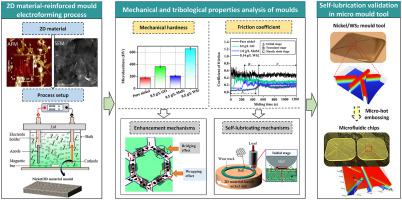International Journal of Machine Tools and Manufacture ( IF 14.0 ) Pub Date : 2021-09-21 , DOI: 10.1016/j.ijmachtools.2021.103802 Honggang Zhang 1 , Tianyu Guan 1 , Nan Zhang 1 , Fengzhou Fang 1, 2

|
In the replication of polymeric micro/nano structures, adhesion and friction between mould tool and polymer cause significant feature failure. For the first time, this work developed a novel strategy for the fabrication of high-hardness and self-lubricating 2D material-reinforced nickel mould tools using electroforming to achieve high precision replication of polymeric micro structures. In this study, layered 2D material, including graphene oxide (GO), molybdenum disulfate (MoS2), and tungsten disulfide (WS2), for the fabrication of self-lubricating mould tools, were systematically studied. Our results demonstrated that nickel/WS2 mould tools, followed by nickel/GO and nickel/MoS2 mould tools, presented the most significant microhardness improvement. A maximum microhardness of ∼660 HV together with a minimum crystallite size of 12 nm was achieved from 0.5 g/L WS2, indicating a 3.67 times microhardness increase and 3 times crystallite size reduction relative to the pure nickel mould tool. The enhanced microhardness can be attributed to the 2D material-induced crystal refinement, and inherent hardness and incorporation content of 2D material. Additionally, friction and wear tests revealed that a low concentration of WS2 at 0.14 g/L achieved the lowest coefficient of friction (COF) and superior wear resistance. The COFs in the initial stage and steady state stage were 0.08 and 0.18, respectively, implying decreases of 42.8% and 72.3%, respectively, and a 27-fold increase in lifetime compared with those of the pure nickel mould tool. Such a significant improvement in tribological properties was due to the formation of self-lubricating transfer film by the interlayer shear effect of few-layered 2D material nanosheets. Finally, defect-free polymeric microfluidic chips were micro hot embossed using an optimal self-lubricating nickel/WS2 mould tool for validation. This work provides significant insight into the fabrication of potential self-lubricating micro/nano mould tools for microfluidics applications.
中文翻译:

使用电铸制造永久性自润滑二维材料增强镍模具
在聚合物微/纳米结构的复制中,模具和聚合物之间的粘附和摩擦会导致显着的特征失效。这项工作首次开发了一种使用电铸制造高硬度和自润滑二维材料增强镍模具的新策略,以实现聚合物微结构的高精度复制。在这项研究中,系统地研究了用于制造自润滑模具的层状二维材料,包括氧化石墨烯 (GO)、二硫酸钼 (MoS 2 ) 和二硫化钨 (WS 2 )。我们的结果表明,镍/WS 2模具工具,其次是镍/GO 和镍/MoS 2模具工具,呈现出最显着的显微硬度改进。0.5 g/L WS 2的最大显微硬度为~660 HV,最小微晶尺寸为12 nm ,表明相对于纯镍模具,显微硬度增加了3.67 倍,微晶尺寸减少了3 倍。显微硬度的提高可归因于二维材料诱导的晶体细化,以及二维材料的固有硬度和掺入含量。此外,摩擦和磨损测试表明,低浓度的 WS 2在 0.14 g/L 时实现了最低的摩擦系数 (COF) 和卓越的耐磨性。初始阶段和稳态阶段的 COF 分别为 0.08 和 0.18,这意味着与纯镍模具相比,分别降低了 42.8% 和 72.3%,寿命增加了 27 倍。摩擦学性能的显着改善是由于少层二维材料纳米片的层间剪切效应形成了自润滑转移膜。最后,使用最佳自润滑镍/WS 2模具工具对无缺陷聚合物微流体芯片进行微热压印以进行验证。这项工作为用于微流体应用的潜在自润滑微/纳米模具工具的制造提供了重要的见解。



























 京公网安备 11010802027423号
京公网安备 11010802027423号